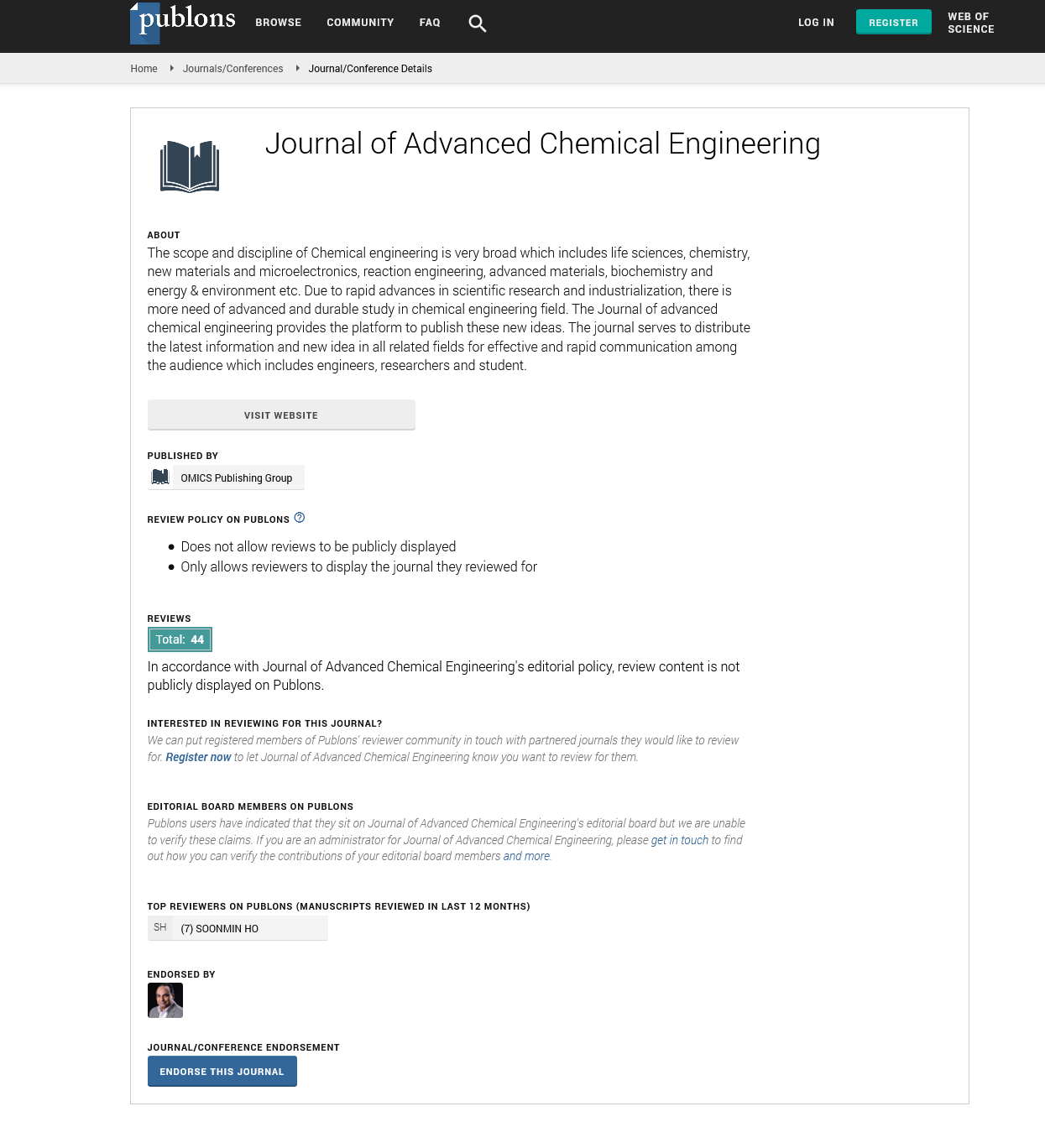Indexed In
- Open J Gate
- Genamics JournalSeek
- Smithers Rapra
- RefSeek
- Directory of Research Journal Indexing (DRJI)
- Hamdard University
- EBSCO A-Z
- OCLC- WorldCat
- Scholarsteer
- Publons
- Geneva Foundation for Medical Education and Research
- Google Scholar
Useful Links
Share This Page
Journal Flyer

Open Access Journals
- Agri and Aquaculture
- Biochemistry
- Bioinformatics & Systems Biology
- Business & Management
- Chemistry
- Clinical Sciences
- Engineering
- Food & Nutrition
- General Science
- Genetics & Molecular Biology
- Immunology & Microbiology
- Medical Sciences
- Neuroscience & Psychology
- Nursing & Health Care
- Pharmaceutical Sciences
Opinion Article - (2025) Volume 15, Issue 2
The Future of Hydrogen Economy: Chemical Engineering Study
Aakash Menon*Received: 30-May-2025, Manuscript No. ACE-25-29811; Editor assigned: 02-Jun-2025, Pre QC No. ACE-25-29811 (PQ); Reviewed: 16-Jun-2025, QC No. ACE-25-29811; Revised: 23-Jun-2025, Manuscript No. ACE-25-29811 (R); Published: 30-Jun-2025, DOI: 10.35248/2090-4568.25.15.372
Description
Hydrogen has often been described as the fuel of the future, yet for decades, it has remained a distant promise rather than a mainstream reality. Today, however, the convergence of technological innovation, global energy transitions, and urgent climate goals has brought hydrogen back into the spotlight with unprecedented momentum. Chemical engineering sits at the heart of this hydrogen revolution, as the production, storage, transport, and utilization of hydrogen all involve complex chemical processes that require deep expertise and innovative solutions. The concept of a hydrogen economy, where hydrogen becomes a primary energy carrier alongside electricity, is increasingly being seen as not just a futuristic idea but a necessary pathway to decarbonize hard-to-abate sectors like heavy industry, aviation, and shipping.
Hydrogen is an energy carrier rather than a primary energy source. It must be produced from other resources, such as natural gas, coal, water, or biomass. The environmental impact of hydrogen production depends heavily on the method used. Today, the majority of hydrogen is produced through Steam Methane Reforming (SMR), a process that reacts natural gas with steam to produce hydrogen and carbon dioxide. While effective and relatively low-cost, this method emits significant amounts of COâ??, which undermines the climate benefits of hydrogen. To address this, chemical engineers are advancing Carbon Capture and Storage (CCS) technologies that can be paired with SMR to reduce emissions. This so-called “blue hydrogen” is increasingly seen as a transitional solution, providing low-carbon hydrogen while renewable alternatives scale up.
A more sustainable route is “green hydrogen,” produced by electrolysis of water using renewable electricity. Electrolyzers split water into hydrogen and oxygen, offering a virtually carbon-free product if powered by wind, solar, or hydro energy. Electrolysis technology, however, remains expensive and energy-intensive compared to SMR. Chemical engineers are working to improve electrolyzer efficiency, durability, and scalability. Advances in catalyst materials, membrane technology, and system integration are steadily driving down costs. In addition, the development of high-temperature electrolysis, which uses heat from nuclear or concentrated solar power, offers potential efficiency gains by reducing the electricity required per unit of hydrogen produced.
Beyond production, hydrogen storage and transport represent another set of engineering challenges. Hydrogen is the smallest and lightest molecule, with a low volumetric energy density. This means storing and moving hydrogen requires either compression to high pressures, liquefaction at cryogenic temperatures, or conversion into carrier molecules such as ammonia or methanol. Each approach has trade-offs. Compressed hydrogen tanks are relatively simple but heavy and limited in capacity. Liquefaction increases energy density but requires large amounts of energy for cooling. Chemical carriers offer easier handling and integration into existing infrastructure but require additional steps for hydrogen release. Chemical engineers are exploring novel materials such as metal hydrides, porous carbon, and advanced composites to develop safer, lighter, and more efficient storage solutions.
End-use applications of hydrogen span across energy, industry, and transportation. In the power sector, hydrogen can be used in fuel cells to generate electricity with water as the only emission. Fuel cells are already being deployed in niche markets like forklifts, backup power systems, and buses. Scaling them up to widespread use in cars, trucks, and even airplanes will require further cost reductions and infrastructure development. In industry, hydrogen can replace coal in steelmaking, serve as a feedstock for ammonia and methanol production, and support refining processes. These applications are critical because they represent some of the hardest-to-decarbonize sectors where electrification alone may not be sufficient. Chemical engineers are working on integrating hydrogen into these industries in ways that minimize disruptions while maximizing emission reductions.
A particularly exciting avenue is the use of hydrogen in combination with carbon dioxide to produce synthetic fuels. By capturing COâ?? from the atmosphere or industrial sources and combining it with green hydrogen, it is possible to create hydrocarbons that can replace conventional gasoline, diesel, or jet fuel. These synthetic fuels are compatible with existing engines and infrastructure, offering a near-term pathway to decarbonize aviation and shipping. Chemical engineering innovations in catalysis, process intensification, and reactor design are critical for scaling these technologies to commercial viability.
Citation: Menon A (2025). The Future of Hydrogen Economy: Chemical Engineering Study. Adv Chem Eng. 15:372.
Copyright: © 2025 Menon A. This is an open-access article distributed under the terms of the Creative Commons Attribution License, which permits unrestricted use, distribution, and reproduction in any medium, provided the original author and source are credited.

